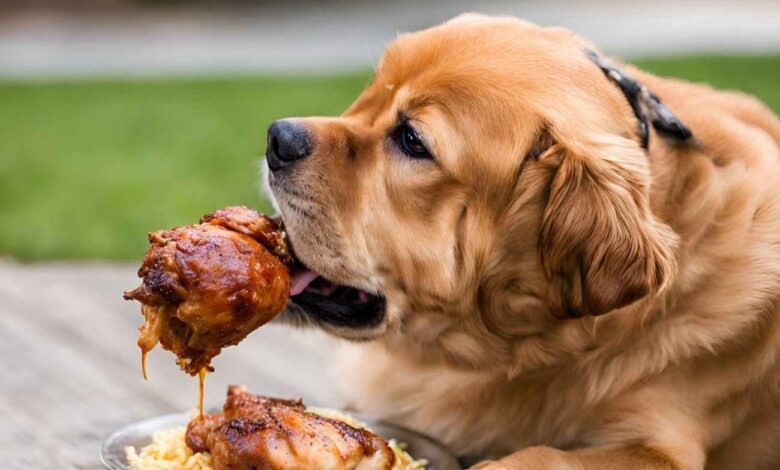Is Orange Chicken Bad for Dogs? Understanding the Risks

Orange chicken, a delightful fusion of savory and sweet flavors, is a popular dish that tantalizes taste buds with every bite. At its core, orange chicken typically features tender pieces of chicken that are lightly breaded and fried to crispy perfection, then generously coated in a tangy orange-infused sauce. This dish has become a hallmark of Chinese-American cuisine, celebrated for its balance of textures and vibrant taste profile.
The ingredients that constitute orange chicken are relatively straightforward yet crucial to its distinctive flavor. Key components include boneless chicken, usually breast meat, which is coated in a seasoned batter before frying to achieve a crispy exterior. The sauce, which lends the dish its signature tanginess, often includes ingredients such as orange juice or zest for citrusy brightness, soy sauce for savory depth, and a hint of sweetness from sugar or honey.
While orange chicken is beloved by many, it’s important to be mindful of certain ingredients that may pose risks, particularly for our canine companions. Ingredients like garlic and onions, commonly used in some recipes, can be harmful to dogs if consumed in sufficient quantities, potentially leading to gastrointestinal issues or more severe health complications. Additionally, the high sodium content in both the chicken itself and the sauce can be problematic for dogs, contributing to salt poisoning if ingested excessively.
When comparing homemade orange chicken to restaurant versions, variations in ingredients become apparent. Homemade recipes often allow for greater control over ingredient quality and quantities, offering flexibility to adjust flavors and nutritional content according to personal preferences. In contrast, restaurant-prepared orange chicken may contain higher levels of sodium or added sugars for flavor enhancement and preservation purposes.
This introductory section aims to provide a comprehensive overview of the ingredients in orange chicken, highlighting both its allure and potential considerations, especially in relation to canine health. By understanding these components and variations, readers can make informed choices about enjoying this beloved dish responsibly and safely.So let’s explore that-can dogs eat Orange chicken?
Nutritional Analysis of Orange Chicken
Orange chicken, a popular dish in Chinese-American cuisine, offers a blend of flavors and textures that can be appealing. Understanding its nutritional composition helps evaluate its suitability for both humans and dogs:
Breakdown of Macronutrients:
- Protein: Orange chicken primarily derives protein from chicken breast, providing approximately 20-25 grams per serving. Protein is essential for muscle maintenance and repair in both humans and dogs.
- Fat: The dish contains fats from frying and the sauce, contributing to its texture and flavor. A typical serving of orange chicken can have around 10-15 grams of fat.
- Carbohydrates: Found in the batter and sauce, carbohydrates offer energy. Orange chicken may contain 30-40 grams of carbohydrates per serving.
Caloric Content per Serving:
- Orange chicken’s caloric content varies based on portion size and preparation methods. On average, a single serving can range from 300 to 500 calories.
- For comparison, this amount represents a significant portion of a small dog’s daily caloric requirement, emphasizing the need for moderation when feeding to pets.
Comparison of Nutritional Needs between Dogs and Humans:
- Protein Requirements: Dogs require higher protein content in their diet compared to humans, with specific amino acids crucial for their muscle and organ function.
- Fat and Carbohydrates: Dogs utilize fats for energy, but excessive intake can lead to obesity and related health issues. Carbohydrates should be limited as dogs have a lower requirement compared to humans.
- Caloric Needs: Dogs’ daily caloric intake varies widely based on factors such as size, breed, age, and activity level. It’s essential to adjust portion sizes to avoid overfeeding and weight gain.
Understanding these nutritional aspects helps pet owners make informed decisions about feeding orange chicken to their dogs. Moderation and consideration of a dog’s specific dietary needs are critical to ensuring their health and well-being when sharing human foods. Always consult with a veterinarian before introducing new foods to your dog’s diet, especially those with potential risks or unknown reactions.
Specific Risks Associated with Orange Chicken
Orange chicken, while flavorful and popular among humans, poses specific risks to dogs due to its ingredients and preparation methods. Understanding these risks can help pet owners make informed decisions about feeding this dish to their canine companions:
High Sodium Levels and Risks of Salt Poisoning in Dogs:
- Orange chicken dishes often contain high levels of sodium, primarily from the sauce and seasoning.
- Dogs are more sensitive to sodium than humans, and excessive intake can lead to salt poisoning.
- Symptoms of salt poisoning in dogs include excessive thirst, vomiting, diarrhea, lethargy, and in severe cases, seizures or organ damage.
Effects of Spices and Seasonings on Canine Health (e.g., Garlic Toxicity):
- Some recipes for orange chicken may include ingredients like garlic or onion powder, which are toxic to dogs.
- Garlic, in particular, contains compounds that can damage a dog’s red blood cells, leading to anemia or other serious health issues.
- Even small amounts of garlic or onion can accumulate over time and pose a risk to a dog’s health.
Impact of Added Sugars on a Dog’s Metabolism and Weight:
- The sauce used in orange chicken often contains added sugars to enhance flavor.
- High sugar consumption can contribute to weight gain, obesity, and may increase the risk of diabetes in dogs.
- Monitoring and limiting added sugars in a dog’s diet is crucial to maintaining their overall health and preventing metabolic disorders.
Considerations:
- Read Labels Thoroughly: When purchasing or preparing orange chicken for dogs, carefully read labels and avoid dishes that contain harmful ingredients like garlic, onions, or excessive sodium.
- Moderation is Key: If feeding small amounts of orange chicken to dogs as a treat, ensure it’s a rare indulgence and does not compromise their balanced diet.
- Consult with a Veterinarian: Before introducing new foods or treats to your dog’s diet, including orange chicken, consult with a veterinarian for guidance tailored to your dog’s specific health needs and dietary restrictions.
By being aware of these specific risks associated with orange chicken and taking proactive measures to mitigate them, pet owners can ensure their dogs’ safety and well-being while still enjoying occasional treats responsibly. Prioritizing your dog’s health through informed dietary choices and consultation with a veterinarian promotes a happy and healthy life for your furry friend.
Potential Health Issues from Feeding Orange Chicken
Feeding orange chicken to dogs, while tempting due to its flavors, can lead to several potential health issues that pet owners should be aware of:
Gastrointestinal Upset (Vomiting, Diarrhea):
- The rich sauce and seasonings in orange chicken can irritate a dog’s stomach lining, leading to gastrointestinal upset.
- Symptoms may include vomiting, diarrhea, abdominal pain, and discomfort.
- Dogs may have varying tolerances to spicy or rich foods, so observing their response after consumption is crucial.
Risk of Pancreatitis from Fatty or Spicy Foods:
- Orange chicken often contains fried chicken and a sauce rich in fats, which can trigger pancreatitis in dogs.
- Pancreatitis is an inflammation of the pancreas and can cause severe abdominal pain, vomiting, diarrhea, and in severe cases, can be life-threatening.
- Dogs with a history of pancreatitis or those prone to digestive issues should avoid foods high in fat or spices.
Allergic Reactions and Their Symptoms in Dogs:
- Dogs can develop allergies to ingredients in orange chicken, such as chicken, certain spices, or additives in the sauce.
- Allergic reactions in dogs may manifest as itching, redness or swelling of the skin, hives, ear infections, or gastrointestinal disturbances.
- Severe allergic reactions can lead to difficulty breathing, swelling of the face or throat, and require immediate veterinary attention.
Preventive Measures:
- Introduce New Foods Gradually: When introducing orange chicken or similar foods to your dog’s diet, start with small amounts to monitor their tolerance and any adverse reactions.
- Monitor Health: Watch for any signs of gastrointestinal upset, pancreatitis, or allergic reactions after feeding.
- Consult with a Veterinarian: Seek advice from a veterinarian before feeding new foods to your dog, especially if they have existing health conditions or dietary sensitivities.
By understanding these potential health issues associated with feeding orange chicken and taking proactive steps to minimize risks, pet owners can prioritize their dog’s health and well-being. Choosing appropriate and balanced diets tailored to their specific nutritional needs is essential for maintaining their overall health and happiness.
Signs Your Dog May Have Had a Negative Reaction
When feeding your dog new foods like orange chicken, it’s essential to monitor for signs of negative reactions. Here are key symptoms to watch for that may indicate different types of adverse reactions:
Symptoms of Salt Poisoning or Sodium Ion Poisoning:
- Excessive Thirst: Your dog may drink more water than usual.
- Vomiting and Diarrhea: These are common signs of salt poisoning in dogs.
- Lethargy: Your dog may appear unusually tired or lethargic.
- Tremors or Seizures: In severe cases, salt poisoning can lead to tremors or seizures.
Indicators of Gastrointestinal Distress Post-Consumption:
- Vomiting: Your dog may vomit shortly after consuming the orange chicken.
- Diarrhea: Loose or watery stools may occur, indicating gastrointestinal upset.
- Abdominal Pain: Signs of discomfort or tenderness in the abdominal area.
Signs of an Allergic Reaction:
- Itching: Your dog may scratch excessively or show signs of skin irritation.
- Swelling: Particularly around the face, muzzle, or throat.
- Difficulty Breathing: Labored breathing, coughing, or wheezing, indicating potential respiratory distress.
Immediate Actions to Take:
- Cease Feeding: Stop feeding orange chicken or any new food suspected to cause adverse reactions immediately.
- Provide Water: Ensure your dog has access to fresh water to help dilute any toxins and maintain hydration.
- Monitor Closely: Observe your dog closely for any worsening symptoms or signs of distress.
- Contact Veterinarian: If symptoms persist or worsen, especially in cases of severe reactions like difficulty breathing or seizures, seek veterinary care immediately.
Preventive Measures:
- Start Slowly: Introduce new foods gradually and in small amounts to monitor your dog’s tolerance.
- Know Your Dog’s Sensitivities: Be aware of any existing allergies or sensitivities your dog may have to specific ingredients.
- Consult with Veterinarian: Always consult with a veterinarian before introducing new foods to your dog’s diet, especially if your dog has a history of health issues or allergies.
By recognizing these signs of negative reactions and taking prompt action, pet owners can help ensure their dog’s safety and well-being when exploring new foods or treats like orange chicken. Prioritizing your dog’s health through informed dietary choices and consultation with a veterinarian promotes a happy and healthy life for your furry companion.
Expert Advice on Feeding Dogs Human Food
Feeding dogs human food can be a source of joy and companionship, but it requires careful consideration to ensure their health and well-being. Here’s expert advice on safety incorporating human food into your dog’s diet:
General Guidelines for Safely Feeding Human Food to Dogs:
- Quality and Ingredients: Choose human foods that are safe and nutritious for dogs, such as lean meats (cooked without seasoning), vegetables (dog-safe varieties), and fruits (seedless and in moderation).
- Avoid Harmful Ingredients: Steer clear of foods toxic to dogs, including chocolate, grapes, raisins, onions, garlic, and foods high in salt or sugar.
- Moderation is Key: Offer human food as occasional treats rather than a significant portion of their diet to maintain balance and prevent nutritional deficiencies or excesses.
Recommendations for Appropriate Treats and Portion Sizes:
- Healthy Treat Options: Opt for dog-specific treats or small portions of dog-safe human foods as treats, such as plain cooked chicken, carrots, or blueberries.
- Portion Control: Adjust treat sizes based on your dog’s size, activity level, and dietary needs to prevent overfeeding and weight gain.
- Nutritional Balance: Ensure treats complement your dog’s regular diet and do not exceed 10% of their daily caloric intake to maintain a balanced nutrition profile.
Importance of Consulting a Veterinarian Before Introducing New Foods:
- Individual Health Considerations: Dogs have unique nutritional requirements and may have allergies or sensitivities to certain foods.
- Health Monitoring: Veterinarians can provide personalized advice on suitable foods, monitor your dog’s health response to new foods, and help prevent potential health issues.
- Preventive Care: Regular veterinary consultations help ensure your dog receives appropriate nutrition and remains in optimal health throughout their life stages.
By following these expert guidelines and consulting with a veterinarian, pet owners can enrich their dog’s diet with safe and nutritious human foods while promoting their overall health and happiness. Responsible feeding practices contribute to a long and fulfilling life for your canine companion.




